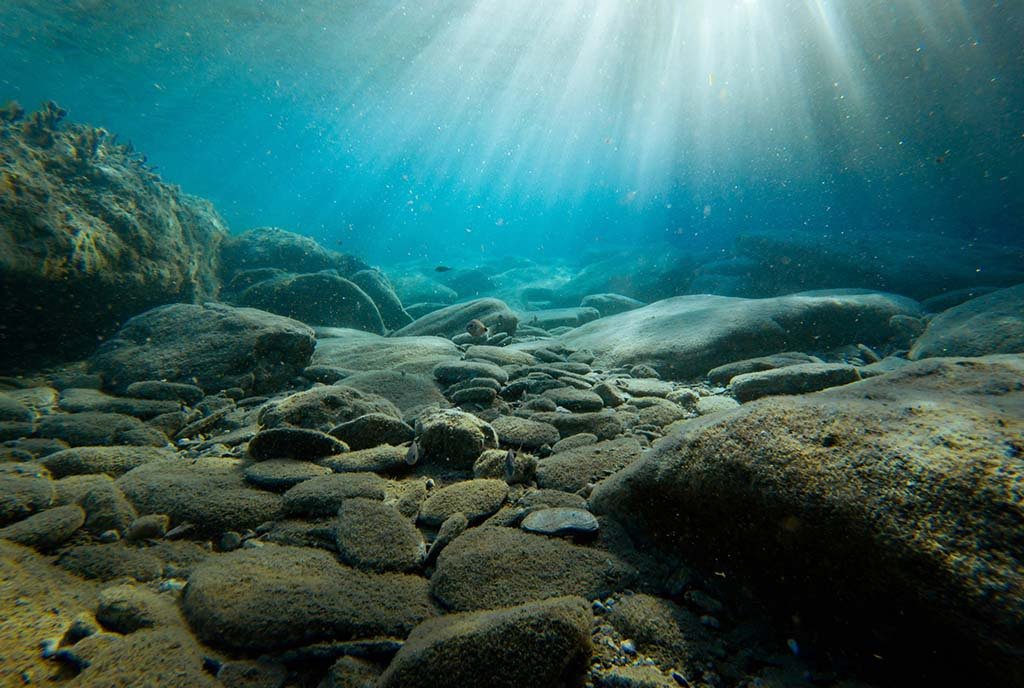
“It will change the bottom of the sea forever,” warned Dr. Sandor Mulsow. A United Nations scientist and professor of marine biology at the Universidad Austral de Chile in Valdivia, Chile, Mulsow spoke to NPQ about deep seabed mining. This is the process of extracting mineral deposits from the ocean floor at depths of 660 feet and below—and the focus of Deep Rising, a new documentary produced and directed by award-winning filmmaker Matthieu Rytz.
Deep Rising premiered at the Sundance Film Festival and was widely released on movie screens in the United States and Canada starting in November. Mulsow is one of the subjects of the film, as is Gerard Barron, CEO of The Metals Company, formerly known as DeepGreen, a company that produces metals from rocks excavated from the bottom of the ocean.
“There is no other planet in our solar system with life as we understand it. The only difference is that Earth has seawater.”
It’s a dangerous undertaking for the oceans and the many organisms that live there, according to Mulsow. In an interview, he told NPQ about the long-term consequences of disrupting the ecosystem, even in relatively small areas, citing empirical data “from more than 15 studies on the physical perturbance of the deep sea—only a few meters wide—that after 40 years show no recovery at all.” The area deep sea mining will disturb in pursuit of mineral-rich rocks is much, much larger.
The Need for Metals
Miles below the surface, fields of rocks cover the ocean floor. Called polymetallic nodules, these rocks contain multiple minerals, including nickel, copper, cobalt, and manganese. Such minerals are needed to build batteries for electric vehicles. The website of The Metals Company describes polymetallic nodules as “a battery in a rock.”
The need for those batteries is increasing, as sales of electric vehicles are “growing faster than any other major category of automobile,” according to the New York Times. The article continued, “Americans will buy more than one million of them [in 2023], a record.” Over a three-month period this year in the United States, battery-powered cars represented 8 percent of the new cars sold—an increase from only 6 percent the entire previous year.
The ocean is “the planet’s last untouched wilderness.”
Electric cars depend on minerals. The Washington Post noted, “Their production can exact a significant human and environmental cost. To run, EVs [electric vehicles] require six times the mineral input, by weight, of conventional vehicles, excluding steel and aluminum.” Such minerals are in limited supply, and extracting them takes a huge toll on Earth’s oceans, according to scientists like Mulsow. He describes the ocean as “the vault of DNA of the planet—life came from the sea.”
“There is no other planet in our solar system with life as we understand it. The only difference is that Earth has seawater,” Mulsow said. It’s not only ocean organisms at risk if the seas are in danger, but all life on land, too. “Without seawater, as it is right now, physically, chemically…we will suffer unknown negative impacts on all the species on land supported by the oceans.”
Who Owns the Sea?
The beauty and wonders of the ocean are given multiple scenes in Deep Rising, narrated by actor Jason Momoa. Species from squids to sea cucumbers, crabs to cookie-cutter sharks call the sea floor home. That’s not even counting the aquatic life that hasn’t been discovered yet. As the film’s synopsis states, the ocean is “the planet’s last untouched wilderness.” And who exactly owns it is a looming question.
Sign up for our free newsletters
Subscribe to NPQ's newsletters to have our top stories delivered directly to your inbox.
By signing up, you agree to our privacy policy and terms of use, and to receive messages from NPQ and our partners.
The organization tasked with overseeing deep sea mining is the International Seabed Authority, established by the 1982 United Nations Convention on the Law of the Sea. Mulsow is the former head of their Office of Environmental Management and Mineral Resources. Conflicting ownership claims of territorial seas was an issue raised to the UN in 1967. Mulsow said that their decision was “to name all the goods of the sea, including the seafloor, as the common heritage of mankind. This means all those goods belong to me, to you, and to everyone, but at the same time to no one because it is for the future generations.”
Yet private companies and some countries are quickly gaining momentum in mining the deep sea, including De Beers Group, China Minmetals Corporation, Seabed Minerals Authority, and many more. The company featured in Deep Rising, The Metals Company, is pursuing mining the bottom of the Clarion-Clipperton Zone in the ocean between Hawaii and Mexico. One of the concerns of scientists, including Mulsow, is that such mining disturbs and potentially harms the sea by generating large sediment clouds that cannot be contained in one area of water. That sediment could impact ocean life far from the actual mining site.
A 2022 study by researchers at MIT measured the sediment kicked up by “tractor-sized” deep sea mining vehicles, which “vacuum up the nodules along the sea floor.” The study found that most of the sediment generated by these vehicles settled back down to the bottom of the ocean or stayed “within 2 meters of the seafloor as a low-lying cloud.” But the study warns: “There is, however, no guarantee that the sediment always stays there rather than drifting further up in the water.”
“We do not need to convince ourselves. We need to desperately provide the rest of the world with [the] scientific basis to make the right decisions.”
Running Out of Time
Advocates for deep sea mining claim it is less destructive to the environment than mining the land, but oceanic mining hasn’t been extensively studied to know this for certain. “It would take decades of study to get a holistic assessment,” as NPR reported—and companies in pursuit of profits aren’t willing to wait. According to NPR, “The world does not have decades to decide how to handle climate change. And, when it comes to regulating deep sea mining, the international community may have even less time.”
Like all Earth’s resources, the mineral-rich rocks along the seafloor are finite. Once they’re gone, they’re gone. And Mulsow—who grew up 11 miles from the Pacific Ocean and knew his calling even as a young child (“There was no way that I would not be doing something about the sea.”)—says the ocean needs to be “represented in every discussion table that takes and will take place.” He’s devoted his career to speaking and advocating for the sea.
Several years ago, after an autoimmune disorder disabled the use of his dominant hand, he started making art about the oceans, too. He now composes music and believes art is one of the many forms we can use to sound the alarm about climate change and the dangers facing the oceans.
“Researchers account for 0.1 percent of the global population,” he told NPQ. “We do a good job, I would like to think, but we are the only ones reading about our findings. We do not need to convince ourselves. We need to desperately provide the rest of the world with [the] scientific basis to make the right decisions.”
“Art and not only tangible art is needed. We also need poets [and] singers…to spread the dangers of intervening in the deep sea without enough knowledge about it,” Mulsow said. “Life depends on the oceans.”











